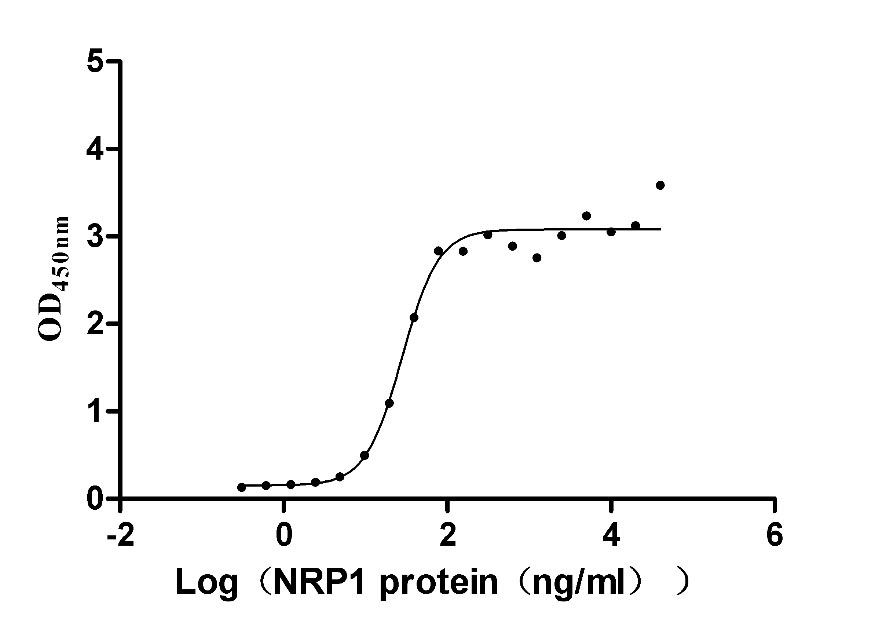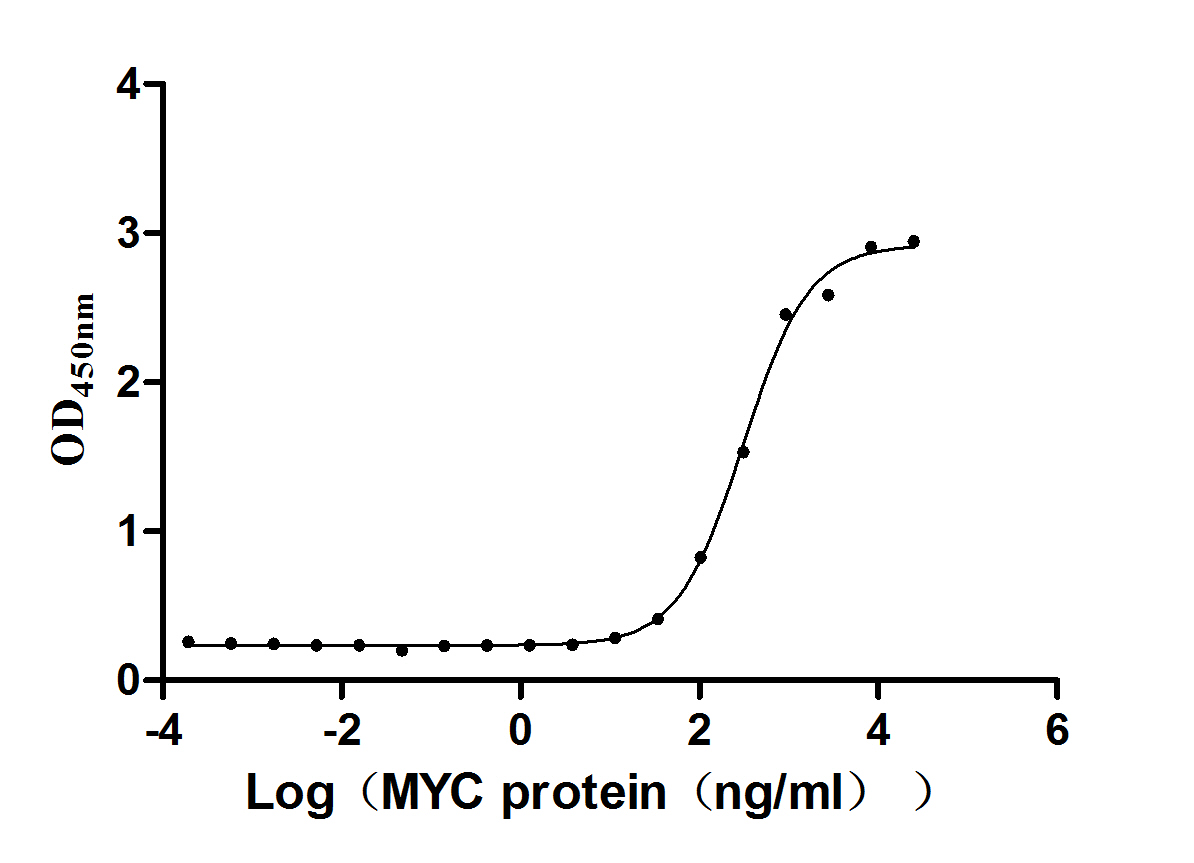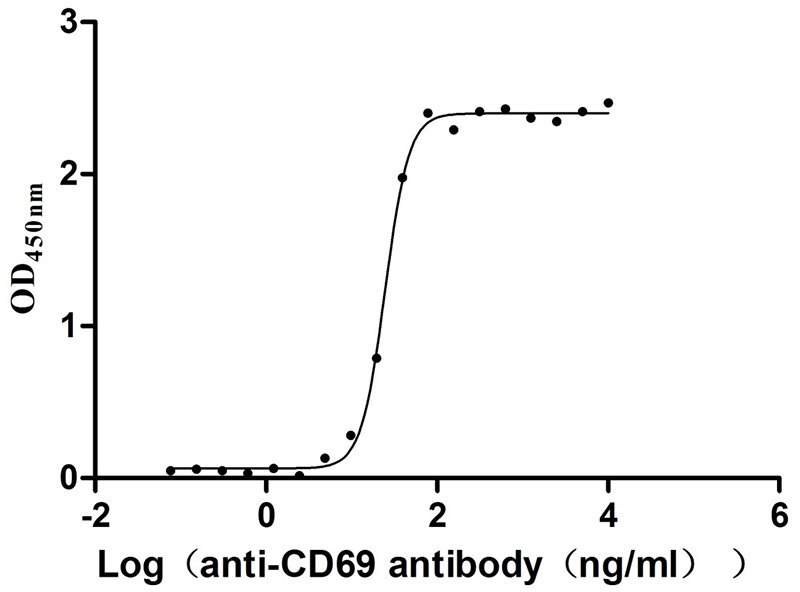Recombinant Mouse Microtubule-associated protein tau (Mapt)
-
中文名称:小鼠Mapt重组蛋白
-
货号:CSB-EP013481MO
-
规格:
-
来源:E.coli
-
其他:
-
中文名称:小鼠Mapt重组蛋白
-
货号:CSB-EP013481MO-B
-
规格:
-
来源:E.coli
-
共轭:Avi-tag Biotinylated
E. coli biotin ligase (BirA) is highly specific in covalently attaching biotin to the 15 amino acid AviTag peptide. This recombinant protein was biotinylated in vivo by AviTag-BirA technology, which method is BriA catalyzes amide linkage between the biotin and the specific lysine of the AviTag.
-
其他:
-
中文名称:小鼠Mapt重组蛋白
-
货号:CSB-BP013481MO
-
规格:
-
来源:Baculovirus
-
其他:
产品详情
-
纯度:Greater than 85% as determined by SDS-PAGE.
-
基因名:Name:Mapt Synonyms:Mtapt, Tau
-
Uniprot No.:
-
别名:Mapt; Mtapt; Tau; Microtubule-associated protein tau; Neurofibrillary tangle protein; Paired helical filament-tau; PHF-tau
-
种属:Mus musculus (Mouse)
-
蛋白长度:Full Length of Mature Protein
-
表达区域:2-733
-
氨基酸序列ADPRQEFDT MEDHAGDYTL LQDQEGDMDH GLKESPPQPP ADDGAEEPGS ETSDAKSTPT AEDVTAPLVD ERAPDKQAAA QPHTEIPEGI TAEEAGIGDT PNQEDQAAGH VTQGRREGQA PDLGTSDWTR QQVSSMSGAP LLPQGLREAT CQPSGTRPED IEKSHPASEL LRRGPPQKEG WGQDRLGSEE EVDEDLTVDE SSQDSPPSQA SLTPGRAAPQ AGSGSVCGET ASVPGLPTEG SVPLPADFFS KVSAETQASQ PEGPGTGPME EGHEAAPEFT FHVEIKASTP KEQDLEGATV VGVPGEEQKA QTQGPSVGKG TKEASLQEPP GKQPAAGLPG RPVSRVPQLK ARVASKDRTG NDEKKAKTST PSCAKAPSHR PCLSPTRPTL GSSDPLIKPS SPAVSPEPAT SPKHVSSVTP RNGSPGTKQM KLKGADGKTG AKIATPRGAA SPAQKGTSNA TRIPAKTTPS PKTPPGSGEP PKSGERSGYS SPGSPGTPGS RSRTPSLPTP PTREPKKVAV VRTPPKSPSA SKSRLQTAPV PMPDLKNVRS KIGSTENLKH QPGGGKVQII NKKLDLSNVQ SKCGSKDNIK HVPGGGSVQI VYKPVDLSKV TSKCGSLGNI HHKPGGGQVE VKSEKLDFKD RVQSKIGSLD NITHVPGGGN KKIETHKLTF RENAKAKTDH GAEIVYKSPV VSGDTSPRHL SNVSSTGSID MVDSPQLATL ADEVSASLAK QGL
-
蛋白标签:Tag type will be determined during the manufacturing process.
The tag type will be determined during production process. If you have specified tag type, please tell us and we will develop the specified tag preferentially. -
产品提供形式:Lyophilized powder
Note: We will preferentially ship the format that we have in stock, however, if you have any special requirement for the format, please remark your requirement when placing the order, we will prepare according to your demand. -
复溶:We recommend that this vial be briefly centrifuged prior to opening to bring the contents to the bottom. Please reconstitute protein in deionized sterile water to a concentration of 0.1-1.0 mg/mL.We recommend to add 5-50% of glycerol (final concentration) and aliquot for long-term storage at -20℃/-80℃. Our default final concentration of glycerol is 50%. Customers could use it as reference.
-
储存条件:Store at -20°C/-80°C upon receipt, aliquoting is necessary for mutiple use. Avoid repeated freeze-thaw cycles.
-
保质期:The shelf life is related to many factors, storage state, buffer ingredients, storage temperature and the stability of the protein itself.
Generally, the shelf life of liquid form is 6 months at -20°C/-80°C. The shelf life of lyophilized form is 12 months at -20°C/-80°C. -
货期:Delivery time may differ from different purchasing way or location, please kindly consult your local distributors for specific delivery time.Note: All of our proteins are default shipped with normal blue ice packs, if you request to ship with dry ice, please communicate with us in advance and extra fees will be charged.
-
注意事项:Repeated freezing and thawing is not recommended. Store working aliquots at 4°C for up to one week.
-
Datasheet :Please contact us to get it.
相关产品
靶点详情
-
功能:Promotes microtubule assembly and stability, and might be involved in the establishment and maintenance of neuronal polarity. The C-terminus binds axonal microtubules while the N-terminus binds neural plasma membrane components, suggesting that tau functions as a linker protein between both. Axonal polarity is predetermined by tau localization (in the neuronal cell) in the domain of the cell body defined by the centrosome. The short isoforms allow plasticity of the cytoskeleton whereas the longer isoforms may preferentially play a role in its stabilization.
-
基因功能参考文献:
- that tau modulates motility in a motor-specific manner to direct intracellular transport PMID: 29077261
- the AD-like tau accumulation induces anxiety through disrupting miR92a-vGAT-GABA signaling, which reveals molecular mechanisms underlying the anxiety behavior in AD patients and potentially leads to the development of new therapeutics for tauopathies. PMID: 28129110
- These results show for the first time that the phosphorylation and isoform alteration of tau are regulated differently during mouse development. PMID: 29196605
- In adult and aged tau(+/+), tau(+/-), tau(-/-) mice tau deficiency could not induce significant motor disorders. However, found lower expression levels of transcription factors Orthodenticle homeobox 2 (OTX2) of midbrain dopaminergic neurons in older aged mice. Results suggested that tau deficiency alone might not be enough to mimic the pathology of Parkinson's disease. PMID: 29337233
- Tau deletion increased ATP production and improved the recognition memory and attentive capacity of juvenile mice. PMID: 30077079
- MAPT variant interaction with mutant amyloid protein precursor causes frontotemporal dementia. PMID: 29729423
- These results establish that in addition to the neuritic plaque, a second determinant is required to drive the conversion of wild-type tau. PMID: 27373369
- miR-322 promotes Tau phosphorylation via negatively controlling BDNF-TrkB receptor activation PMID: 29464486
- High tau expression is associated with blood vessel abnormalities and angiogenesis in Alzheimer's disease. PMID: 29358399
- Disinhibiation of Gas6 binding to Tyro3 due to PGRN reduction results in activation of PKCalpha via PLCgamma, inducing tau phosphorylation at Ser203, mislocalization of tau to dendritic spines, and spine loss. PMID: 29382817
- frontotemporal dementia and parkinsonism linked to chromosome 17 tau with a mutation in the C-terminal region had different banding patterns, indicating a different phosphorylation pattern. PMID: 27641626
- For the three conditions, FRAP analysis revealed a similar mobility in dendrites compared with axons; however, Tau-mEOS2 was less mobile than hWT-Tau and hP301L-Tau and the mobile fraction was smaller, possibly reflecting less efficient microtubule binding of Tau when over-expressed. Together, our study presents Tau-mEOS2 mice as a novel tool for the study of Tau in a physiological and a pathological context. PMID: 27378256
- Chronic Dyrk1 inhibition reversed cognitive deficits in Alzheimer's disease transgenic mice via reduction of APP and phosphorylated tau pathology. PMID: 28779511
- Results suggest the importance of the autophagosome for the low-frequency stimulation-induced oligomerization of tau and suggest a reason for its age dependency. Interestingly, the lysosomal disturbance promoted the formation of the fibrillar form of aggregates consisting of hyper-phosphorylated tau. PMID: 28874186
- deletion or inhibition of the cytoplasmic shuttling factor HDAC6 suppressed neuritic tau bead formation in neurons. PMID: 28854366
- The present findings support the idea that the progressive accumulation of phospho-tau is associated with structural alterations of the GA, and that these changes may occur in the absence of Abeta pathology. PMID: 28922155
- MicroRNA-146a suppresses ROCK1 allowing hyperphosphorylation of tau in Alzheimer's disease. PMID: 27221467
- results demonstrate that ApoE affects tau pathogenesis, neuroinflammation, and tau-mediated neurodegeneration independently of amyloid-beta pathology; ApoE4 exerts a 'toxic' gain of function whereas the absence of ApoE is protective PMID: 28959956
- Study demonstrated that, in ob/ob mice, type 2 diabetes leads to a progressive tau hyperphosphorylation due to hypothermia, which is reversed by normothermia but not by acute leptin injections or 15 weeks caffeine treatment. PMID: 27793638
- study reports that tau is present in the heart and loss of tau in the heart causes elevated blood pressure and altered cardiac performance in aged mice. PMID: 28059795
- These data are consistent with other observations that the rapidly depositing Tg4510 mouse is a challenging model in which to demonstrate efficacy of tau-lowering treatments compared to some other preclinical models of tau deposition/overexpression. PMID: 28655349
- Data show that tau promotes excitotoxicity by a post-synaptic mechanism. PMID: 28883427
- Tau as an essential mediator of the adverse effects of stress on brain structure and function. PMID: 27274066
- Study demonstrated that phosphorylated-tau spreads gradually and selectively from the injured cortex to other brain regions after traumatic brain injury and that all of the affected regions are part of the working memory circuit. PMID: 28163095
- Study demonstrates a mechanistic link between brain Abeta deposition and CSF tau, and thus, CSF tau may present an important readout of Abeta deposition in mouse models and likely in Alzheimer's disease. PMID: 27750032
- Tau efflux from the brain to the blood was evaluated by administering radioactively labeled and unlabeled tau intracerebroventricularly in wild-type and tau knock-out mice, respectively. The efflux of Tau, including a fraction via CNS-derived L1CAM exosomes, was observed in mice. Tau is readily transported from the brain to the blood. PMID: 27234211
- Somatodendritic accumulation of Tau in Alzheimer's disease is promoted by Fyn-mediated local protein translation. PMID: 28864542
- Intermittent hypoxia treatment (IHT)-induced cognitive impairment may be partially explained by the fact that IHT increases phosphorylated tau via biological processes common to aging. PMID: 28057021
- Pin1 serves as a positive regulatory molecule of proplatelet formation of megakaryocytes by enhancing the function of phosphorylated tau. PMID: 28943044
- PGRN decrease, resulting from pathogenic mutations, might compromise the trophism of cortical neurons by affecting GluN2B-contaning NMDA receptors PMID: 28899992
- These data provide evidence that amyloid beta acts to enhance tau pathology by increasing the formation of tau species capable of seeding new aggregates. PMID: 28500862
- These results suggest that tau haploinsufficiency, without the compensation effect of MAP1A, induces reduction of Otx2 expression, increases prenatal cell death, and accordingly leads to selective loss of VTA DA neurons in the early postnatal stage. PMID: 28424350
- High-glucose induces tau hyperphosphorylation through activation of TLR9-P38 MAPK pathway. PMID: 28803064
- these results uncover a novel role for mDia1 in Abeta-mediated synaptotoxicity and demonstrate that inhibition of MT dynamics and accumulation of PTMs are driving factors for the induction of tau-mediated neuronal damage. PMID: 28877993
- The authors show here that miR-132 loss exacerbates both amyloid and TAU pathology via inositol 1,4,5-trisphosphate 3-kinase B (ITPKB) upregulation in an Alzheimer's disease mouse model. PMID: 27485122
- TIA1 knockdown or knockout inhibits tau misfolding and associated toxicity in cultured hippocampal neurons, while overexpressing TIA1 induces tau misfolding and stimulates neurodegeneration. PMID: 27160897
- Data suggest that a switch in post-translational processing of Tau from acetylation at Lys321 to phosphorylation at Ser324 coordinately regulates Tau aggregation and may be relevant in tauopathy and Alzheimer disease; acetylation/phosphorylation of Tau appears to be controlled by Hdac6 (histone deacetylase 6 protein). PMID: 28760828
- ROS produced by 1,2-diacetylbenzene causes tau hyperphosphorylation via GSK-3beta phosphorylation and it might be related to impaired memory deficit. PMID: 28734998
- tau overexpression mediates the excitatory toxicity induced by E-NMDAR activation through inhibiting ERK phosphorylation. PMID: 27809304
- Data suggest that a presumed diffusion barrier within axon initial segment (AIS) regulates wild-type Tau sorting: retrograde (axon-to-soma) and anterograde (soma-to-axon) sorting of Tau. Tau isoforms without N-terminal inserts are sorted efficiently into axons; a longer isoform (2N4R-Tau) is partially retained in cell bodies/dendrites and accelerates spine/dendrite growth. PMID: 28536263
- This study establishes a mouse model of sporadic tauopathies and points to important differences between tau fibrils that are generated artificially and authentic ones that develop in Alzheimer's disease brains. PMID: 27810929
- tau diffusion on microtubules enables to keep microtubules evenly distributed in axonal sections at low tau levels. PMID: 27076215
- Upregulating HSF1 relieves the tau toxicity in N2a-TauRD DeltaK280 by reducing CHOP and increasing HSP70 a5 (BiP/GRP78). Our work reveals how the bidirectional crosstalk between the two stress response systems promotes early tau pathology and identifies HSF1 being one likely key player in both systems. PMID: 28678786
- our findings suggest that tau is a common downstream factor in both amyloid-dependent and-independent pathogenic mechanisms and therefore could be a more effective drug target for therapeutic intervention in AD. PMID: 27459671
- Study focused functional consequences of human tau accumulation: aging htau mice (deficient of murine tau but express all six human tau isoforms) compared with murine tau knock-out and C57Bl/6J mice; reduced food-burrowing performance was the most robust aspect of the htau phenotype with aging, htau phenotype appeared stronger than the mtau(-/-) phenotype at young ages but milder with aging. PMID: 27167086
- Results may provide support for the hypothesis that enhanced expression of tau following lipopolysaccharide administration is a protective measure by hippocampal neurons to compensate for the loss of the microtubule-stabilizing protein due to phosphorylation. More importantly, our results support the hypothesis that blocking the production of Abeta that follows inflammation also leads to reduced tau phosphorylation PMID: 27320209
- Study identified microtubule-associated protein tau as a highly sensitive constituent of the cytoskeleton in the presence of experimental stroke, thus providing novel evidence for a pivotal role of cytoskeletal elements under ischemic conditions PMID: 27189884
- These findings suggest that TDP-43 promotes tau exon 10 inclusion and 4R-tau expression and that disease-related changes of TDP-43, truncations and mutations, affect its function in tau exon 10 splicing, possibly because of TDP-43 mislocalization to the cytoplasm. PMID: 28487370
- Thus, these data demonstrate that Tau(-/-) mice show impairments in the maturation of newborn granule neurons under basal conditions and that they are insensitive to the modulation of adult hippocampal neurogenesis exerted by both stimulatory and detrimental stimuli. PMID: 27198172
- this work provides insights into postsynaptic processes in Alzheimer's disease pathogenesis and challenges a purely pathogenic role of tau phosphorylation in neuronal toxicity. PMID: 27856911
显示更多
收起更多
-
相关疾病:May be involved in the pathogenesis of cytoplasmic inclusions (as Mallory bodies) in livers of mice chronically intoxicated with Griseofulvin or DDC (3,5-diethoxycarbonyl-2,4-dihydrocollidine), a model for human alcoholic hepatitis. Alteration of Tau (abnormal phosphorylation and cross-linking) could contribute to Mallory bodies formation and disturbance of microtubule function in alcoholic liver disease.
-
亚细胞定位:Cytoplasm, cytosol. Cell membrane; Peripheral membrane protein; Cytoplasmic side. Cytoplasm, cytoskeleton. Cell projection, axon. Cell projection, dendrite. Secreted.
-
组织特异性:Expressed in neurons and at a lower level in the liver and kidney. Isoform PNS-tau is expressed in the peripheral nervous system while the others are expressed in the central nervous system.
-
数据库链接:
Most popular with customers
-
Recombinant Human Neuropilin-1 (NRP1) (Active)
Express system: Mammalian cell
Species: Homo sapiens (Human)
-
Recombinant Human papillomavirus type 16 Protein E7 (E7) (Active)
Express system: E.coli
Species: Human papillomavirus type 16
-
Recombinant Dog Angiopoietin-2 (ANGPT2) (Active)
Express system: Mammalian cell
Species: Canis lupus familiaris (Dog) (Canis familiaris)
-
Recombinant Macaca fascicularis Claudin (CLDN18)-VLPs (Active)
Express system: Mammalian cell
Species: Macaca fascicularis (Crab-eating macaque) (Cynomolgus monkey)
-
Recombinant Macaca fascicularis lymphocyte antigen 6 family member G6D (LY6G6D) (Active)
Express system: Yeast
Species: Macaca fascicularis (Crab-eating macaque) (Cynomolgus monkey)
-
Recombinant Human Desmoglein-2 (DSG2), partial (Active)
Express system: Mammalian cell
Species: Homo sapiens (Human)
-
Recombinant Human Early activation antigen CD69 (CD69), partial (Active)
Express system: Mammalian cell
Species: Homo sapiens (Human)
-
Recombinant Human Serine/threonine-protein kinase receptor R3 (ACVRL1), partial (Active)
Express system: Baculovirus
Species: Homo sapiens (Human)




















